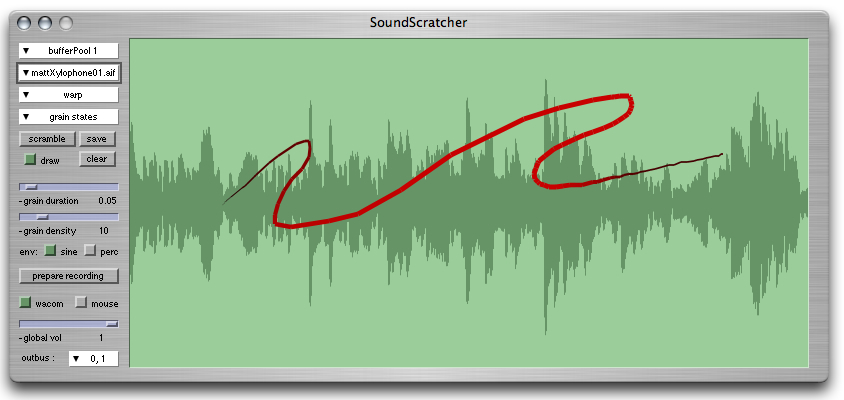The SoundScratcher is an instrument that graphically represents
the waveform of a sample buffer. Any buffer stored in RAM can be manipulated
by the instrument. The instrument receives input from hardware such as
the mouse or a Wacom tablet and the basic idea is that the user can draw
on top of the waveform representation and control the playback of the
sound that way.
There are various interactive modes in which the user can play with the
sound:
warp – a granular synthesis where the location in
the sound file is played constantly using overlapping soundgrains. Here
the vertical location of the cursor represents the pitch;
scratch – by moving the pen (or some other sensor
input) the user can scratch the buffer forwards and backwards like a needle
on a turntable. In the spirit of turntables, the speed of the gestural
movement maps naturally to the pitch;
random grains – here grains are represented as dots
on the canvas. The sound engine reads randomly though an array of the
locations of those dots, creating a granular cloud. The density of the
cloud, the envelope length and envelope type of each grain can be controlled
from the interface;
linear grains – same functionality as in random
grains, but here the sound engine reads linearly through the list of grains.
However, there is a randomising button on the left of the interface where
you can randomise the list if you so wish. These settings can be stored
using the "save" button and retrieved from the "settings"
drop down menu.
worm – the worm is a creature that moves over the
space of the sound with variable numbers of grains in its spine. The speed
of the worm and the grain duration can be controlled; Press "a"
to add grains to the tail of the worm and "s" to remove grains
(or number of dots).
graincircles – these are circles of variable size
and amplitude (represented as alpha in colour) inside which the sound
engine spawns grains according to the set speed. Again the envelope and
duration of the grain can be controlled. Press the Z key to UNDO (if you
create a circle that you didn't like).
grainsquares – as opposed to the graincircles the
squares always play the grains from the left point of its location. This
makes it easier to create interesting rhythms and periodic sound textures
than in the random space of the circles. The speed of the grain repetition
can be affected in both the graincircles and the grainsquares by pressing
the 1, 2, 3, or 4 number keys, representing the respective time relationships
(3 against 2 or 4 against 3, etc.) Press the Z key to UNDO (if you
create a circle that you didn't like).
We recommend using the Wacom tablet here as the instrument is more expressive
this way, i.e. pressure on the tablet is translated to amplitude control
of the soundgrains/scratch.
The gestural movements of the user can be recorded, stored and played
back by the instrument itself. (the record/play path button has 4states:
"prepare recording", "record", "recording",
and "play" - it has these states in order for the user to trigger
the recording from the SPACE button on the keyboard). That way the user
can draw patterns on the instrument and leave it to perform on its own.
The user could then for example open up another instance of Soundscratcher
to perform with.
|

